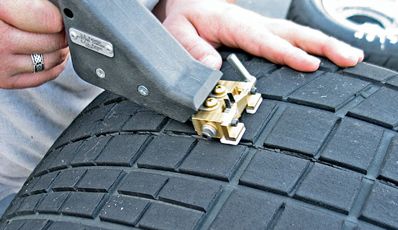
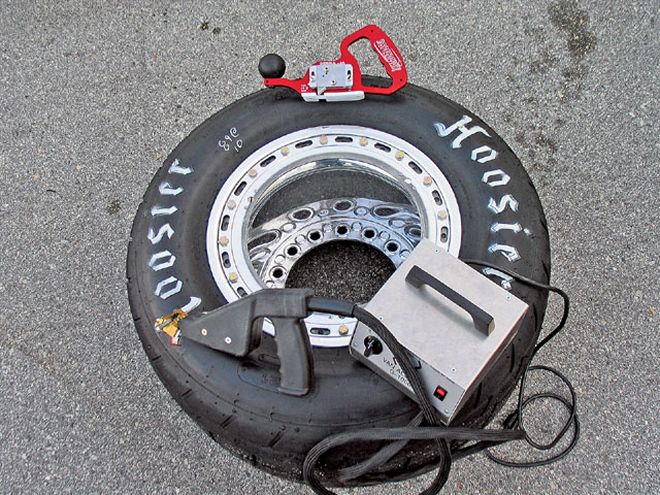
CLICK HERE FOR THE CIRCLE TRACK DOWNLOADABLE TIRE TRACKING CHART
Five, six, or even seven hundred horsepower is worthless unless you can put that power to the track. We get that power to the track through a complex and integrated system of components; transmission, driveshaft, rearend gears, shocks, springs, the list is virtually endless, but one of the most important facets of that whole equation lies within those four pieces of rubber that are mounted to your wheels...the tires.
While asphalt racers are often left with little choice other than air pressure and stagger, venturing onto dirt is a whole new game. Dirt racers have the very difficult task of maximizing grip while the car is traveling down the track both forward and sideways. Most dirt cars enter the corner traveling across the racing surface in a direction that can best be described as a yaw position, posing some serious issues for the selection of tires. Now if the racer is in a class where the tires are regulated or specified, this places them in an even more difficult position.
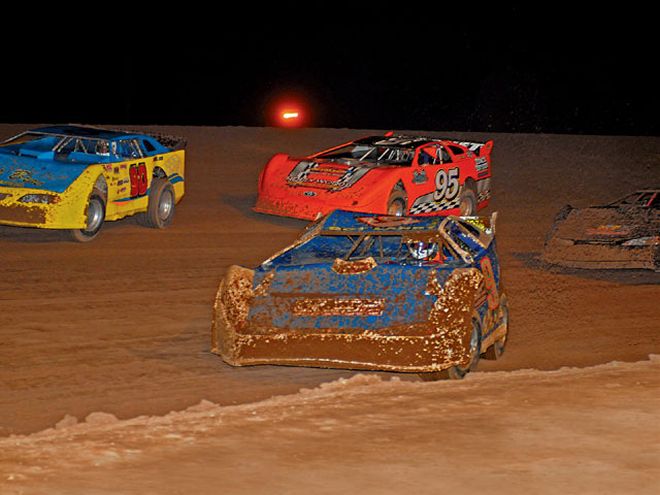 This is a heat race at Central Arizona Raceway in Casa Grande, Arizona. Check out the chunks of sticky mud flying everywhere. The track is characterized as "heavy" at this stage of the night, requiring a lot of grooves in the tires to gain any traction. Photo by Vyn Polmanteer
This is a heat race at Central Arizona Raceway in Casa Grande, Arizona. Check out the chunks of sticky mud flying everywhere. The track is characterized as "heavy" at this stage of the night, requiring a lot of grooves in the tires to gain any traction. Photo by Vyn Polmanteer
The majority of dirt racers are bound by one of three different types of tire rules. There are restrictive rules such as the IMCA's Modified Division which mandates that all competitors run unaltered G60-15 Hoosier Race Tires with the IMCA logo stamped on sidewall. In classes like those there is no grooving, siping, or grinding, nada. This is a pure spec tire rule. Then there are more diverse rules such as those of the National Late Model Series which mandates one manufacturer (Hoosier) but allows three different models, the Spec. D21, Spec. D55 and D70, plus the aforementioned alterations are allowed. Then there is the open tire rule such as the World of Outlaws Late Model Series where any brand is permitted as long as the tire meets WoO's maximum width and circumference specifications.
It's these last two worlds where we are going to delve into in this article. Prepping a tire for dirt racing is an art form unto itself, and the rewards for learning and mastering this art form is added grip, traction, and better tire wear which yields more speed.
There are, as we just mentioned, three basic ways to alter a tire for the benefit of enhanced performance; grooving, siping, and grinding. But understanding the when, how, and why of tire prep starts long before you plug in that groover.
It starts with the dirt you race on. In our research for this article, we ran across a book called Selection & Application of Hoosier Late Model Dirt Racing Tires by C.P. Furney Jr. from 2001. It's chock full of great information on tires for dirt racing but one thing caught our eye. In the book, Furney gives an in depth analysis of the various soil compositions that lead to different types of track conditions and we thought that was pretty critical for you to know. Obviously these differing track conditions influence how you prepare your tires. He defines six different types of track conditions that the dirt track racer could face in an evening of racing.
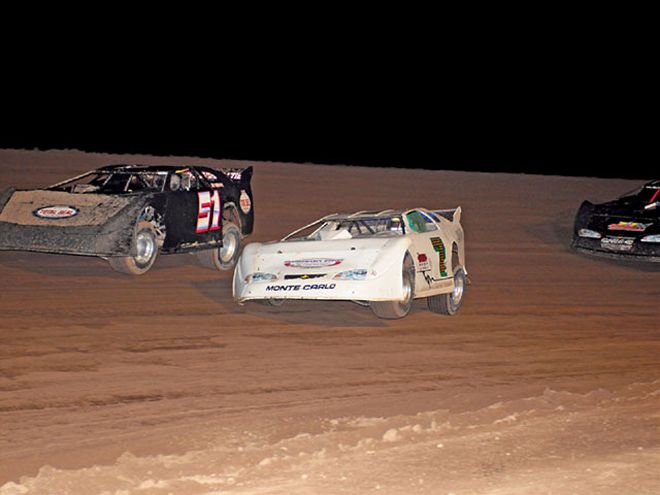 This is the same track, Central Arizona Raceway, but this photo was taken during the feature. Note how different the track is. While still wet, the chunks of flying mud are gone and the track surface is on its way to being black slick, requiring less grooves and some sipes. Photo by Vyn Polmanteer
This is the same track, Central Arizona Raceway, but this photo was taken during the feature. Note how different the track is. While still wet, the chunks of flying mud are gone and the track surface is on its way to being black slick, requiring less grooves and some sipes. Photo by Vyn Polmanteer
Furney defines a slushy track as one where muddy water is thrown up onto the underside of the car, the hood, and the driver's helmet. As the tires dig into the track surface they encounter a certain shear strength of that slushy mud. This shear strength is really the only thing that is giving your tire any sort of traction. Therefore to allow the tire to work to any degree in these conditions you will need a lot of grooves. More than half of the tire (up to 60 percent) should be grooved according to Furney.
One step down from the slushy track is the heavy track, where the tires send chunks of soil flying through the air. These chunks of mud, up to 3/4-inch in diameter have the consistency of soft modeling clay. While most of the traction still comes from the shearing of the soil (a.k.a. tire digging into the surface), some begin to come from the surface of the tire itself. To gain maximum performance you'll want anywhere from 40 to 50 percent of your tires grooved.
A tacky track is characterized by stringy shaped chunks of soil whose consistency resembles stiff or hard modeling clay. Traction on tacky tracks comes approximately 50 percent from shearing of the soil and 50 percent from the tires. Therefore, Furney says you'll want approximately 30 to 40 percent grooving.
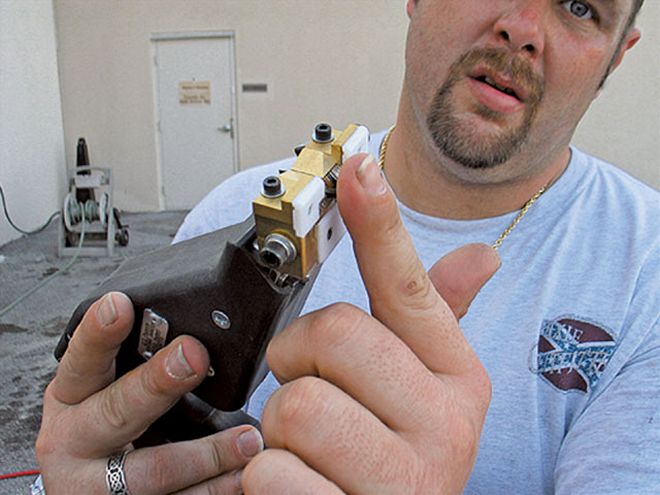 An early Christmas present from Speedway Motors, our patented Van Alstine G-1000 Tire Groover, has an instant-on feature that is cool to the touch until the Teflon pads come in contact with the rubber of the tire. Then the blade gets hot. Photo by Rob Fisher
An early Christmas present from Speedway Motors, our patented Van Alstine G-1000 Tire Groover, has an instant-on feature that is cool to the touch until the Teflon pads come in contact with the rubber of the tire. Then the blade gets hot. Photo by Rob Fisher
CLICK HERE FOR THE CIRCLE TRACK DOWNLOADABLE TIRE TRACKING CHART
Not surprisingly Furney's definition of a shiny track is one that shines under the lights, largely due to the moisture content of the clay. These tracks tend to be very smooth and very slick. The surface wetness of the track makes it very difficult to gain good traction. Furney says you need up to 60 percent grooving on a track like this.
The dry-hard condition is also called black slick, getting that name from the visible black rubber coating that develops on the surface as the tire wear deposits increase as the race wears on. Depending upon atmospheric conditions, dry-hard tracks can be a little as a handful of laps away from going dry slick. Sticky tires are the rule for a dry hard/black slick track. Do not go anymore than 15 percent grooving, siping will also help on this track surface.
Ah dry slick, characterized by the cloud of dust that develops behind the cars, all of your traction on a dry slick surface comes from the tire contacting the track. For these conditions you'll want somewhere in the neighborhood of 15 to 30 percent grooving plus a good deal of siping.
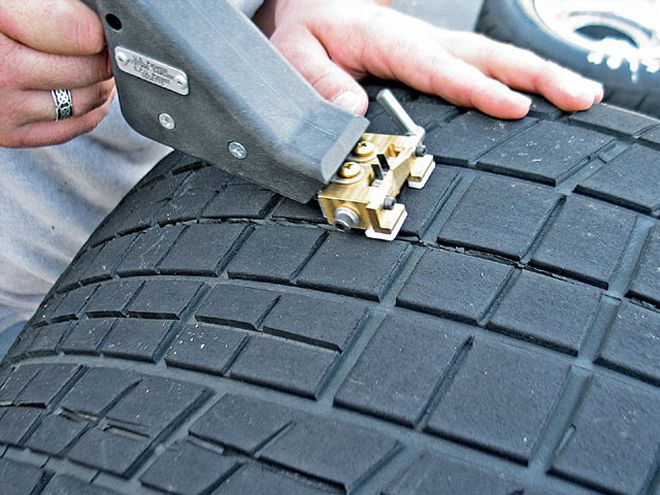 After smoking the tires with the highest setting we backed down to a 3 to groove our Hoosier D21s. This groover made quick work of prepping six tires. Here Bobby Clark cuts circumfrentially grooves on one of the rear tires. It was like a hot knife through butter. Photo by Rob Fisher
After smoking the tires with the highest setting we backed down to a 3 to groove our Hoosier D21s. This groover made quick work of prepping six tires. Here Bobby Clark cuts circumfrentially grooves on one of the rear tires. It was like a hot knife through butter. Photo by Rob Fisher
We haven't been to too many dirt tracks where the surface stays exactly the same from hot laps until the white flag of the feature. That's part of the beauty of dirt track racing. Since surfaces change, how you choose to prep your tires for the evening's action will have a tremendous impact on how well you do. Often times, a track that starts out tacky ends up dry slick. If you've got heavily grooved and siped tires for a tacky race make sure you have another set of tires prepped with less grooves and more sipes for the feature when that track slicks over.
In addition, other factors can contribute to changes in the tracks surface. Take East Bay Raceway Park for example. Given its close proximity to Tampa Bay, a tidal body of water, East Bay's racing surface changes with the tide. When the tide is in, the track tends to be more tacky and stays that way throughout the evening of racing. When the tide is out, dry slick is the rule.
Tracks in other low lying areas can experience the same phenomenon. East Bay track manager Todd Hutto told an interesting story about when the winged limited sprints come to the track. Even with the tide in, the track will go black slick. Hutto suspects that the extra downforce created by the wings cause additional rubber to be literally driven into the track forming a barrier that prevents water from reaching the surface.
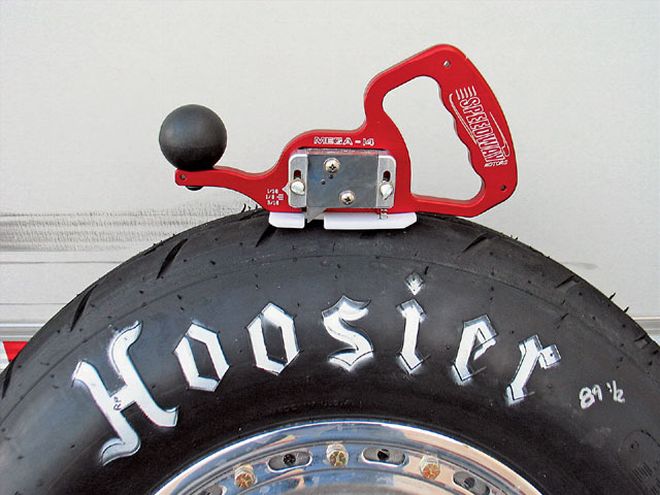 Speedway Motors Mega Siper has 14 adjustable blades. Photo by Rob Fisher
Speedway Motors Mega Siper has 14 adjustable blades. Photo by Rob Fisher
"You can go out to the track after the limited sprints run and take a knife and cut a hole in the track and watch the water come up to the surface, yet the area around the hole will be blacked over and dry," says Hutto.
Not only does that theory stand to reason but it brings up an excellent point. The division or class running in front of you has a lot to do with how the track will act when you go out. So keep an eye out for the order of the classes in addition to everything else.
Now that we've covered the "when" let's take a look at the "how." We'll start with grooving. The art, and we do mean art, of using a heated iron to cut either U-shaped or V-shaped grooves in the surface of the tire. The goal is to get the grooves placed on the tire at the correct angle that will facilitate as much grip as possible. The problem is that grooving can only go so far. You still need a tire surface to meet with the track. Too many grooves and you reduce the surface area of the tire and your grip suffers. That's where analyzing how many grooves you need comes into play.
Understanding that all of the factory pattern grooves are 8/32-inch or 1/4-inch deep is important for two reasons. Number 1: Additional grooves you cut should be the same depth as the factory grooves. Otherwise, as the tire wears your grooves will disappear before the factory's rendering the tire useless. Number 2: If you cut grooves deeper than 9/32-inch you risk cutting in too deep, weakening the tire and eventually causing a blowout.
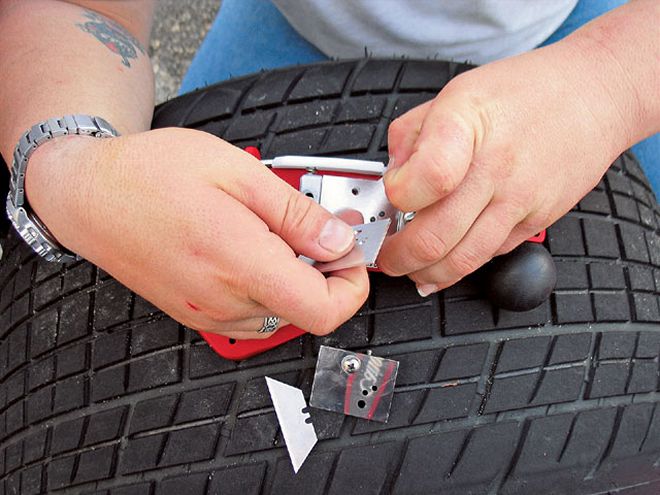 The plates that separate each blade shown above can be placed in different spots to widen or tighten up the space between each sipe. Photo by Rob Fisher
The plates that separate each blade shown above can be placed in different spots to widen or tighten up the space between each sipe. Photo by Rob Fisher
CLICK HERE FOR THE CIRCLE TRACK DOWNLOADABLE TIRE TRACKING CHART
Here's a helpful tip on grooving from Mr. Furney. "For anything under 35 laps, the grooving iron should be adjusted to cut a U-shaped groove with the bottom of the groove no more that 1/4-inch deep or the same as the factory tread groove. For longer features of 50 laps or more, tire wear may be significant. In those cases we need to consider the condition of the track at the end of the race. Often you start tacky and end dry slick. At the green flag you need a lot more grooving than you do at the end of the race. Therefore, for a long race you need to cut a V-groove as opposed to a U-groove. As the surface of the tread wears through the race, the percentage of your grooving will decrease thereby giving you an appropriately prepped tire for a dry-slick track.
For this article Speedway Motors sent us the new state of the art patented Van Alstine G-1000 Tire Groover. This groover has an instant-on feature so that when you touch the Teflon padded head to the tire surface the blade gets hot instantly. After smoking the tires with the highest setting we backed down to a "3" to groove our Hoosier D21s. This groover made quick work of prepping six tires for an upcoming trip to Ocala Speedway, a central Florida high banked half-miler that usually goes somewhere between black slick and dry slick by nights end. Ocala runs the Late Model feature second, so the track should still have some tackiness by the time we get on. The 25-lap feature is not long enough for the V-grooves so we stuck with U-shaped ones and added some sipes.
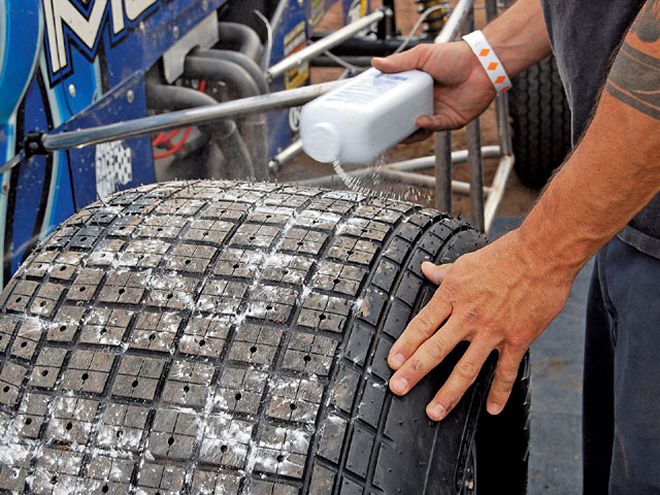 Here's a little tip to make your siping life easier. Ordinary baby powder or talcum powder makes pushing a siper through the tread a bit easier and helps to keep your cuts straighter. Photo by Vahok Hill
Here's a little tip to make your siping life easier. Ordinary baby powder or talcum powder makes pushing a siper through the tread a bit easier and helps to keep your cuts straighter. Photo by Vahok Hill
Speaking of tire siping, did you know that it actually has its origin in the nautical industry? It was discovered that shoes with fine cuts in the soles at right angles to the direction of travel would assist sailors in maintaining a good grip on a wet deck in high seas. While the same principal works for race tires, siping also allows the tires to heat up faster by reducing the stiffness of the tread blocks. This is particularly beneficial on dry-hard/black slick or dry-slick tracks where there tends to be a lot of cautions as the tires will come back up to temperature quicker.
A tire under static load will deflect to a certain degree. A tire under a dynamic lateral load (as in going through a corner) will deflect even more. Siping a tread block increases the deflection and in turn generates more heat, consequently softening the rubber even more, thereby creating greater traction.
Like grooving, how you sipe a tire is directly related to the track conditions. Sipes are by and large useless on wet, heavy tracks and make the most difference on a dry-slick track. They can be as close as 3/16-inch apart, but that takes a lot of skill if you don't have the right tool. Getting them too close together can lead down the path of chunking, which we will get into a little bit later. So to keep our sipes parallel we relied on the Speedway Motors Mega Siper. This siper is machined out of billet aluminum and has 14 adjustable blades. Adjusting the blades is a snap by removing just two screws on either side. We chose a pattern that only used half of the blades because we knew that Ocala would retain some of its tackiness so we didn't need as many sipes as we would have if the track went dry slick.
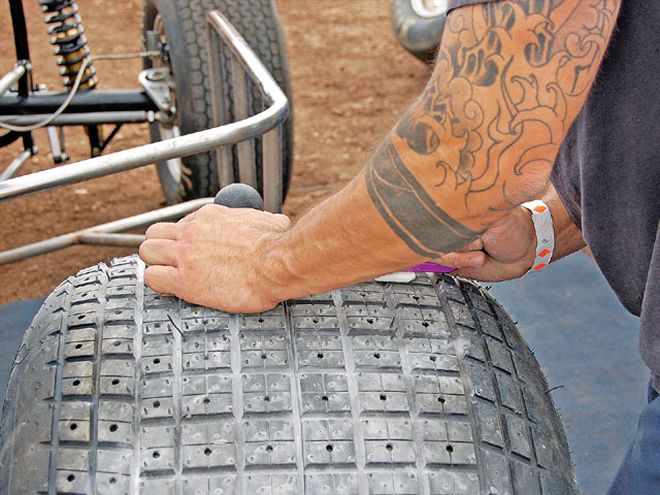 Note how this racer spread the powder evenly over the tire. Photo by Vahok Hill
Note how this racer spread the powder evenly over the tire. Photo by Vahok Hill
Another nice feature of the Mega Siper is that you can vary the distance between each sipe by changing the number of plates in between each blade. Plus, it uses standard utility knife blades that you can buy at your local hardware store.
Grinding is significantly different from grooving or siping, but no less important. Grinding knocks off the new surface of a fresh set of tires. That allows you to immediately utilize the good rubber from the drop of the green. Since you don't have to wait for that top layer to wear off, grinding is particularly useful in short heat races where the tires don't get much wear.
Grinding is also a valuable step in prepping tires that already have some laps on them. Not only will grinding remove the outside work hardened layer of rubber from a used tire, but you can also use a grinder to smooth out inconsistencies to return it to like new status. However, grooving is probably the trickiest of the three tire prepping processes.
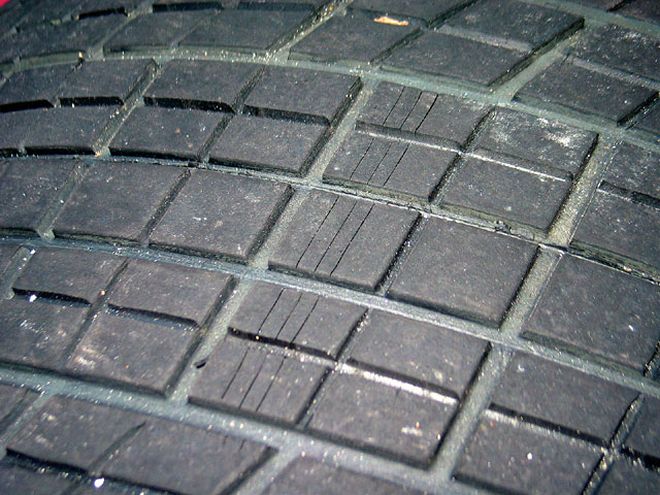 The laser straight sipes from Speedway's Mega Siper can be seen in our test pass on an old tire. Photo by Rob Fisher
The laser straight sipes from Speedway's Mega Siper can be seen in our test pass on an old tire. Photo by Rob Fisher
CLICK HERE FOR THE CIRCLE TRACK DOWNLOADABLE TIRE TRACKING CHART
To do it right for front tires, hold your grinder at a slight angle and grind from the outside of the tire to the inside. For the left sides, do the exact opposite. Since circle track cars are always turning left (we hope) forces are acting on the interior sidewall and trying to push out. Because of this you should also grind outward from the inside edge of the tire. This helps to slightly round off the leading edge of the grooves so that they are less likely to be ripped off under side loading when the car is hooked up.
In a past article on the subject, CT found that many tire specialists prefer different tools for grinding. However, a popular option is a power sander with a variable speed control and replaceable pads; use a slower speed for softer tires and faster speed for harder tires. Use pads between #36 and #40 grit.
Anytime you groove or sipe your tires you need to pay close attention to the depth and spacing of your cuts. Why? Simply put, if you don't do it right you could cause your tires to chunk. Chunking is when small pieces of tire get ripped off of the tread. It's costly, because a chunked tire is a junk tire.
Apart from running a tire that's too soft on a high-grip track, here are a few items that will cause a tire to chunk:
* Too many grooves that weaken the tread blocks, reduce contact patch surface area and make the tire run hotter
* Cutting too many sipes through the tread pattern
* Leaving hard edges
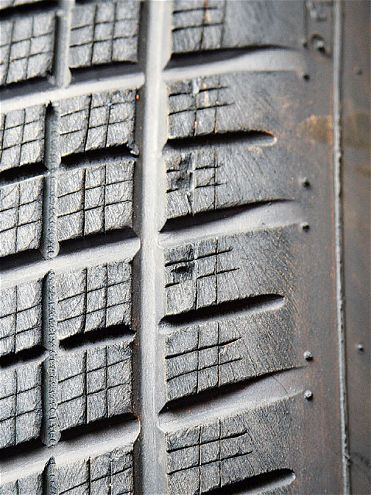 You can notice three chunks in this tire. This is a mild example caused when the rough track tore pieces of rubber out of the tires tread. If you experience this problem try widening the space between your sipes. Photo by Jeff Huneycutt
You can notice three chunks in this tire. This is a mild example caused when the rough track tore pieces of rubber out of the tires tread. If you experience this problem try widening the space between your sipes. Photo by Jeff Huneycutt
Solving those issues is fairly easy, grinding will round off sharp groove edges to reduce the possibility of chunking. In addition, grinding your rear tires twice will help prevent chunks. Grind once laterally (across the tire) to prevent the tread from chunking under sideloading. A second grinding around the circumference of the tire will smooth out the leading edge of the treads so that they won't chunk under acceleration.
Grooves and sipes should always be cut perpendicular to the direction of the stresses applied to the tread. For example, rear tires are subjected to acceleration and braking forces circumferentially. Consequently, those grooves need to be cut across the tire thereby delivering bite in a front to rear direction. However, just because rear tires do not turn as front tires do, doesn't mean that lateral traction isn't important. By cutting grooves and sipes circumferentially around the tire you can increase the lateral traction of the rear tires as you negotiate the corners.
Front tires experience a different set of stresses than the rear tires because you turn your front tires to steer the car. Therefore, grooves and sipes must be cut at an angle in order for them to lay perpendicular to the direction of the tire stresses. Start by holding the tire between your knees and imagining a clock. 6 o'clock would be closest to your body while 12 o'clock would be the farthest away with 9 o'clock to your left and 3 o'clock to your right. You make all of your cuts in a pattern running from 8 o'clock to 2 o'clock. This is important to get right because if you cut the grooves the wrong direction you will reduce the braking force of the front tires and cause the car to push when entering the turn.
Grooving, siping, and grinding on tire is all well and good, but keeping detailed records as part of a tire management program is critical to maximizing your results. Prepping dirt tires is a time consuming task. As such, you want to make sure that you have all the proverbial ducks in a row before you hit the track. So as a little bonus to you, our valued readers, if you head over to www.circletrack.com you can download our very own CIRCLE TRACK Tire Record Sheet that you can print and take to the track.
Prepping a tire for dirt racing is an arduous task that is time consuming and labor intensive. But with the right tools and the right approach you can maximize your performance on the track. And that's what it is all about. If you follow our guidelines in this article and pay very close attention to the track conditions you will be in good shape.